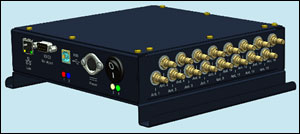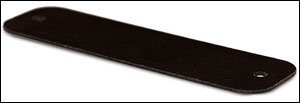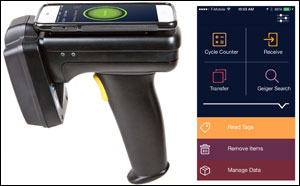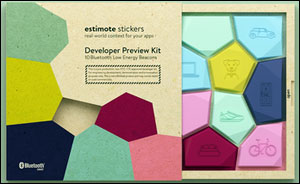Sep 18, 2014The following are news announcements made during the past week by the following organizations:
freaquent froschelectronics;
HID Global;
TSL, Xterprise;
Nordic Semiconductor, Kontakt.io, Estimote;
Apple; and the
Washington Metropolitan Area Transit Authority.
Freaquent Unveils HF Reader Complying With ISO 18000-3 Mode 3 and EPC HF RFID Standards
Freaquent froschelectronics GmbH, an Austrian original equipment manufacturer (OEM) and system provider in the field of radio frequency identification, has introduced a new multi-output high-frequency (HF) reader, the HF RFID Long-Range Interrogator (SLRM 1000), that complies with the ISO 18000-3 Mode 3 and EPC HF RFID standards. According to the company, the new reader system was designed to fully utilize the advantages of the ISO 18000-3 mode 3 standard, as well as support the ISO 15693 standard, making it suitable for document tracking, jewelry tracking and other multi-tag applications. The reader is capable of working with 424 kHz downlink data rates, which the company says makes it "the first HF RFID-system which shows the impressive speed known from UHF systems."
The SLRM 1000, which operates 16 individual antennas, is capable of identifying 450 tags per second. It can read at least 100 stacked or overlapping transponders, supports multi-axis antennas and enables instant movement detection. The device supports variable connectivity via Ethernet, USB or RS232, and has an eight-port decoupled digital input-output (IO) interface. The reader comes with an integrated command library and a software developer's kit (SDK). The demonstration software (GUI) is designed for convenient and fast integration of the reader system into RFID applications, according to freaquent, as well as for minimizing time to market.
At present, the SLRM 1000 is already being used by several customers, including Gaming Partners International (GPI) at the gaming company's Las Vegas headquarters, according to Helmut Köberl, freaquent's CTO and managing director. GP has purchased the exclusive rights to use this reader for casino gaming applications. NXP Semiconductors, which manufacturers ISO 18000-3M3 transponder chips, is utilizing the reader as well, he says, for demonstration purposes.
The SLRM 1000 is no more expensive than multi-output HF readers available for older technologies, Köberl reports. Pricing ranges from $1,300 to $1,700, he says, depending on the quantity ordered.
HID Global Intros Rugged Ultra-Thin Epoxy UHF RFID Tag
HID Global has added an ultrahigh-frequency (UHF) RFID transponder to its Epoxy Tag portfolio. The new Epoxy Tag UHF transponder, according to HID Global, supports the ISO 18000-6C and EPC Gen 2 specifications, and is designed for a broad spectrum of rugged industrial applications. The transponder is encased in a rugged housing composed of epoxy material resistant to moisture (even during high-pressure washes), oils and petroleum, and is tolerant of exposure to mechanical vibration, as well as shock temperatures ranging from -40 degrees to +360 degrees Fahrenheit (-40 degrees to +160 degrees Celsius). The Epoxy Tag UHF transponder can endure repeated sterilization and autoclaving cycles when mounted on medical instruments and devices, the company reports, and can be retrofitted to non-metallic containers or be permanently embedded into industrial components, equipment or containers.
The transponder is made with an Alien Technology's Higgs3 chip, 96 bits of Electronic Product Code (EPC) memory, a 64-bit tag identifier (TID) and 512 bits of user memory. The tag measures 3.3 inches by 1 inch by 0.04 inch (83 millimeters by 25 millimeters by 1 millimeter) , according to the company, and its black rectangular surface may be imprinted with customized artwork, logos and text, as well as bar codes, so the tags are scannable by both RFID and visual ID readers. The Epoxy Tag UHF transponder comes with pre-drilled holes for mounting via screws, though it can also be glued to an object, or be embedded in a custom housing, depending on the application.
TSL Mobile RFID Readers Validated for Xterprise's Clarity Inventory Software
Technology Solutions (UK) Ltd. (TSL) has announced that its Bluetooth-enabled ultrahigh-frequency (UHF) RFID readers have been fully validated for use with the Clarity Inventory software for retail inventory management developed by Xterprise, a subsidiary of the SML Group.
TSL's 1128 Bluetooth UHF RFID Reader and 1153 Bluetooth Wearable UHF RFID Reader can now be paired with a smartphone or a tablet running Clarity Inventory. The Xterprise software is designed to help retailers verify shipments, document the receipt and transfer of merchandise from one store to another, perform inventory counts and search out individual RFID tags using handheld readers, reconcile inventory levels and generate detailed inventory reports at the store level and across the entire retail chain based on sales, among other things. According to Xterprise, Clarity Inventory is available as an application for iOS-powered devices, such as Apple's iPod Touch, iPad and iPhone, and will soon be available for phones and tablets running Microsoft's Windows 8 operating system. Clarity Inventory running on the iOS platforms and using the TLS readers connects to Xterprise's Clarity Inventory central server applications, in which all transactions are managed, numerous inventory reports reside and customer systems integration is conducted, explains Dean Frew, Xterprise's president and CEO. These include inventory reports by site and location, he says, as well as replenishment reports.
According to Frew, the TSL 1128 Bluetooth RFID reader has proven capabilities to scan thousands of items simultaneously—a critical requirement for retail inventory management. A retailer using cloud-based Clarity Inventory software and the TSL RFID reader can improve its business case by as much as 20 percent, versus traditional RFID terminals and other applications.
Nordic Semiconductor Provides Bluetooth Beacon Chips to Kontakt.io, Estimote
Nordic Semiconductor, a fabless semiconductor company specializing in ultra-low-power (ULP) short-range wireless communication, has announced that two beacon providers are using its nRF51822 Systems-on-Chips (SoCs) to provide the Bluetooth Low Energy (BLE)—aka Bluetooth Smart—wireless functionality. Kontakt.io, a startup provider of beacon hardware, back-end and software-development services, has specified the SoCs in its Cloud Beacon, unveiled last month (see RFID News Roundup: Kontakt.io Unveils Cloud Beacon to Manage Bluetooth Beacons). Estimote will employ Nordic's SoCs for its Estimote Stickers—small, thin battery-powered beacons with built-in accelerometers and temperature sensors.
The Nordic nRF51822's ULP operating characteristics are designed to help enable each Kontakt.io Cloud Beacon to run for up to six years from an internal rechargeable battery (under typical usage conditions), if not powered from a main power supply—which is also an option, Nordic Semiconductor notes.
Kontakt.io reports that its Cloud Beacon platform will eventually include a wearable rubber wristband option (that will also incorporate Nordic's wireless technology) for tracking individuals, such as children in schools or out on a day trip, as well as health-care patients, and workers at manufacturing facilities for health and safety purposes.
Szymon Niemczura, Kontakt.io's CEO, says his company has worked with Nordic Semiconductor since day one to enhance Kontakt.io's beacon platform, including the addition of a cloning feature whereby Kontakt.io can send an exact clone of any missing beacon to customers, since the exact configurations of all Kontakt.io beacons are stored in the cloud at all times. What's more, various levels of password protection, security, cloud management, protocol enhancements and hand-shaking routines are in place. Such functions, he says, add up to make a huge difference to what Kontakt.io is able to promise and deliver at the end application stage.
Estimote is utilizing Nordic's nRF51822 SoCs for its Estimote Stickers, which are approximately 3 millimeters (0.1 inch) in thickness and cost less than $10. The thin beacons are designed to be affixed to everyday nearby objects that Estimote calls "nearables." The company carried out all of the design work in-house in partnership with Nordic Semiconductor, in order to achieve the required sticker-sized level of integration required without sacrificing operational reliability or battery life (one year, under typical usage conditions).
Estimote Stickers are available to pre-order now from the Estimote website, and a pack of 10 is expected to retail initially for approximately $99. The Stickers are supported Estimote's existing beacon software development kit (SDK), which the company says is in use by more than 25,000 developers worldwide. Several major industry partners have already signed up to work with the new Sticker hardware, Estimote reports, including Cisco.
Apple Puts Restrictions on NFC in iPhone 6, Watch
Among the various features touted in Apple's new iPhone 6, iPhone 6 Plus and Watch is the addition of Near Field Communication (NFC) technology—which, of course, has been available in a number of Android smartphones for some time. Apple has included NFC as part of Apple Pay, which the company describes as a new mobile-payments service that works with the two new smartphones via an NFC antenna design, a dedicated chip called the Secure Element and the new Touch ID fingerprint scanner (Apple Pay also works with the new Apple Watch, which supports NFC technology).
Unlike the NFC technology available on Android smartphones, which can be used for such broad NFC-enabled applications as pairing devices or unlocking hotel rooms, Apple is restricting NFC functionality to Apple Pay mobile payments. An article posted on Cult of Mac, a daily news website devoted to Apple, reported confirmation from an Apple spokesperson that the NFC technology will be available only for Apple Pay at launch. A CNET article indicated that developers would be restricted from the NFC chip functionality for at least a year. According to CNET, Apple declined to comment on whether NFC capability would remain off limits beyond that period.
D.C.'s Metro Transit Plans NFC-enabled Payment Pilot With Help From Accenture
The Washington Metropolitan Area Transit Authority (Metro) is planning a pilot program to test new fare technology and fare gates that will allow riders to pay for their trips using next-generation smartphones, Near Field Communicaiton (NFC)-enabled watches, contactless credit and debit cards, Federal ID cards and more. The pilot, slated to begin in January 2015, will run at 10 Metrorail stations, six Metrobus routes and two parking facilities. Installation of new fare gates, as well as bus and parking payment targets, for the pilot will commence next month, and will include approximately 2,000 customers. Metro reports that it will begin recruiting customers to participate in the pilot within a few weeks. Metro provides rail, bus and paratransit service to a 1,500-square-mile area that includes Washington, D.C., and surrounding jurisdictions in Maryland and Virginia.
Metro has chosen Accenture to replace the existing fare-collection systems for Metrorail, Metro-operated parking facilities, Metrobus and MetroAccess services. The $184 million contract includes Accenture's development of a system using the Accenture Fare Management Solution, based on commercially off-the-shelf software products. Accenture says it will employ an open architecture that supports a range of payment options, and includes flexibility for future evolution in payment technology.
The solution will include fare vending machines that will have large, intuitive, multilingual displays and fully comply with the Americans With Disabilities Act. Onboard each Metrobus, Accenture explains, there will be a new target for customers to tap, and MetroAccess customers will be able to validate their trips using the driver's smartphone and his or her own customer ID card.
Metro anticipates lower ongoing maintenance costs as a result of the more modern, component-based technology, Accenture reports. Travel transactions and fare calculations will be performed by a central data system, and an equipment-monitoring system will manage maintenance and repair functions. If the pilot is successful, Metro says, it plans to replace the now decades-old fare gates and vending machines at station entrances across the system, and add new payment targets onboard buses and at parking facilities, starting in 2017.
The design, development and deployment of this new system will be a multi-year initiative, Metro indicates. Once the technology is fully deployed, customers will see approximately 1,000 fare gates (including ADA fare gates), 450 fare vending machines, approximately 1,500 bus payment targets, about 160 new payment targets at parking exit lanes, and around 600 NEPP-compatible smartphones for MetroAccess operators. The new system will not accept paper tickets, and Metro will continue the gradual phasing out of paper fare media. At present, Accenture reports, fewer than one in 10 Metrorail riders pay for their trip via a paper fare card.





